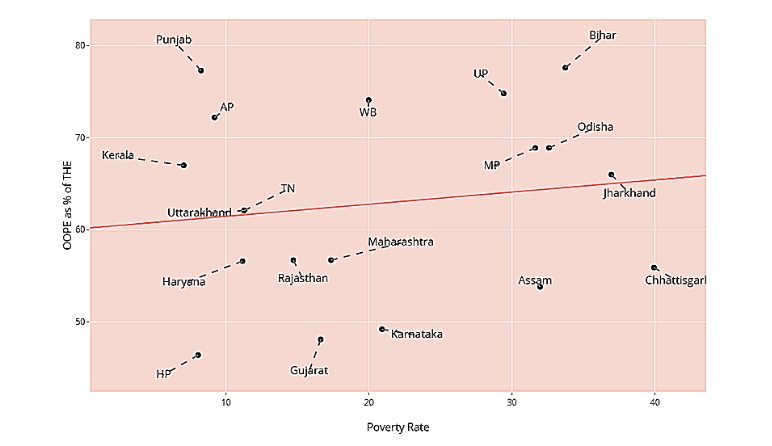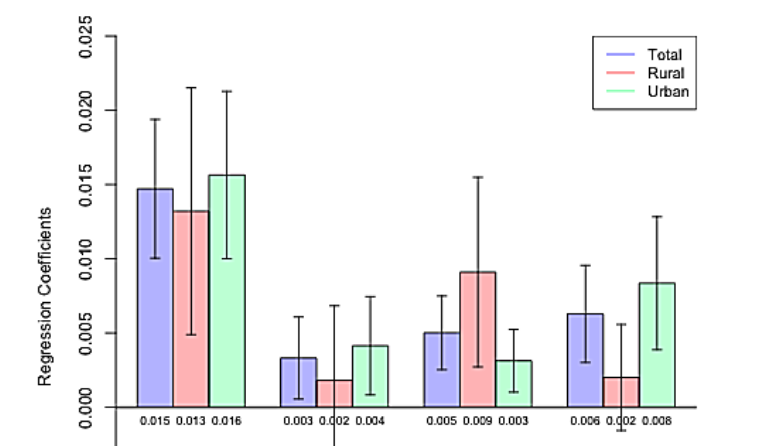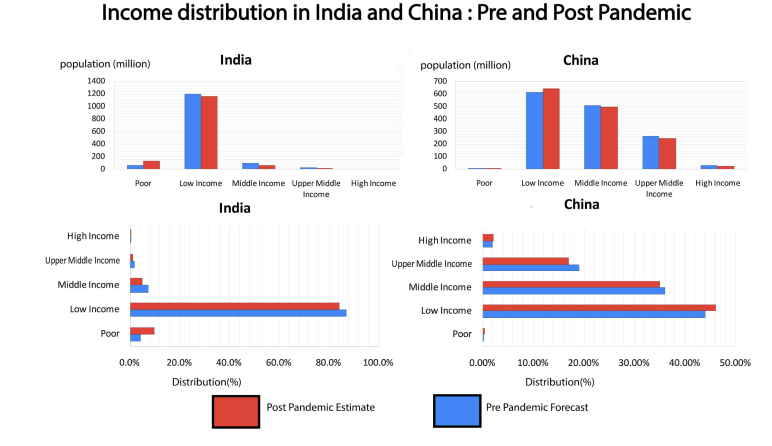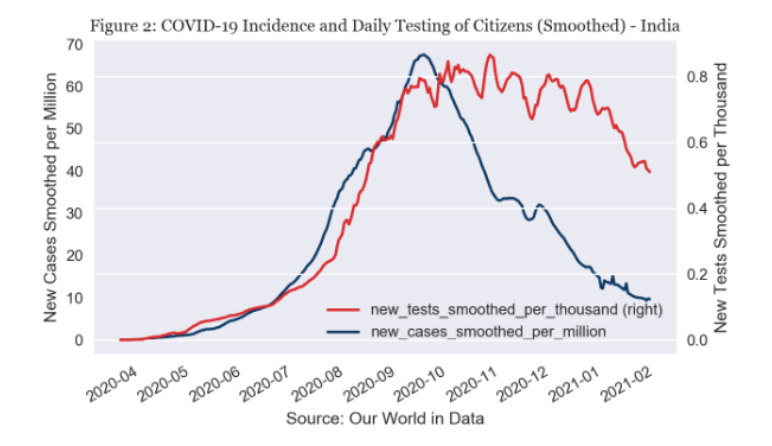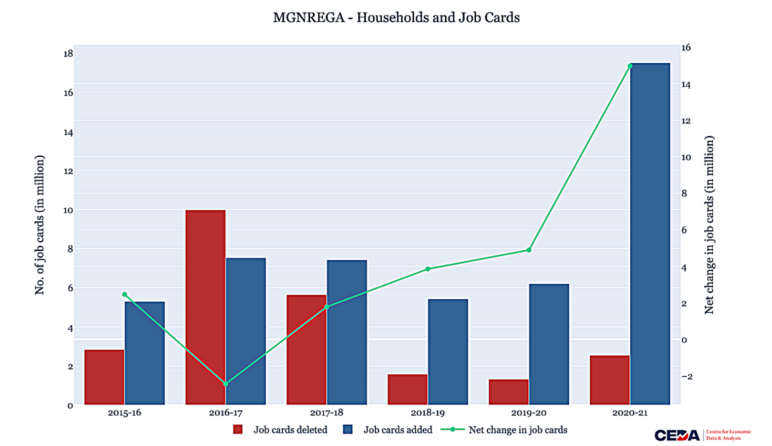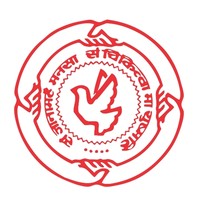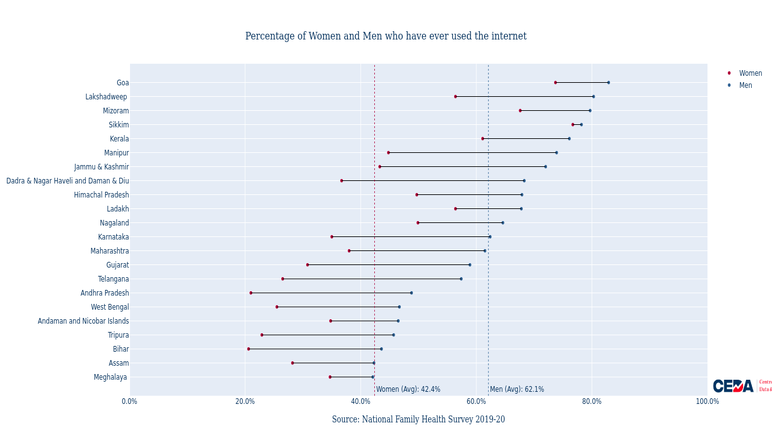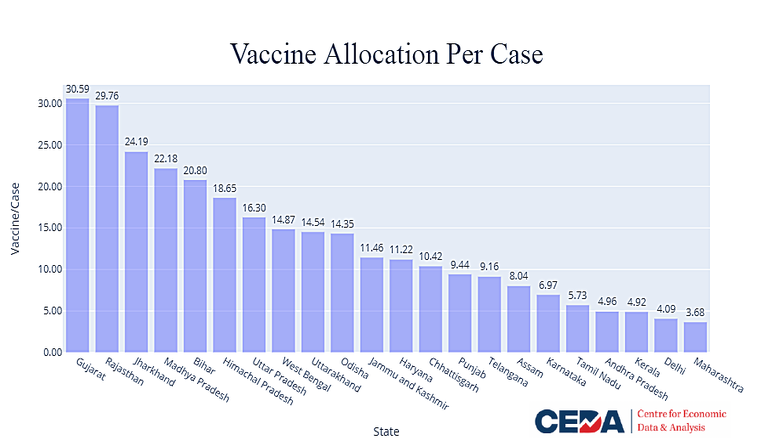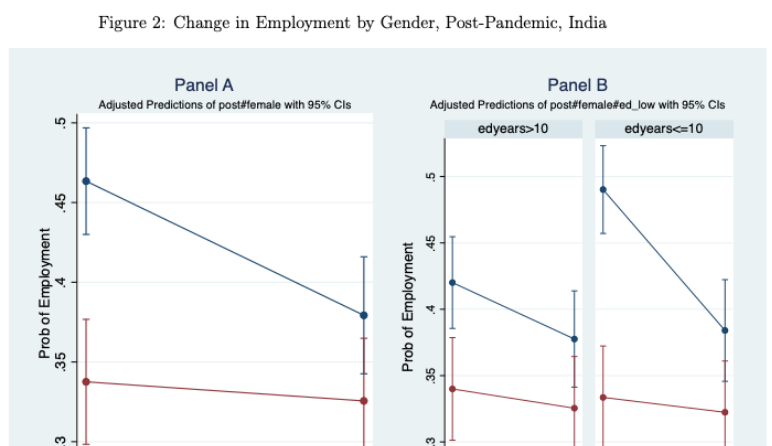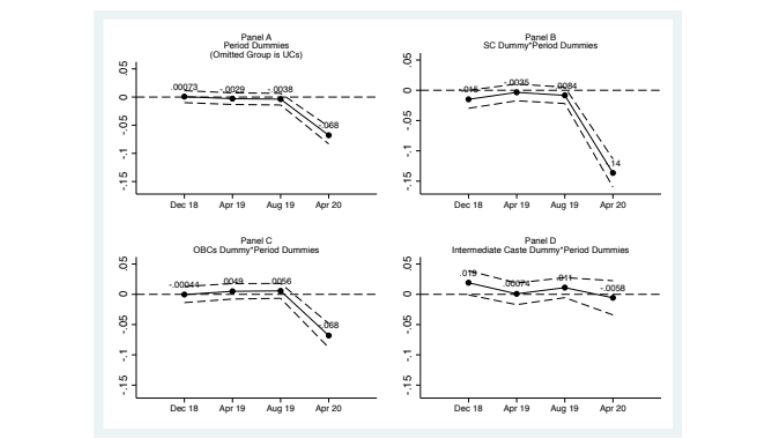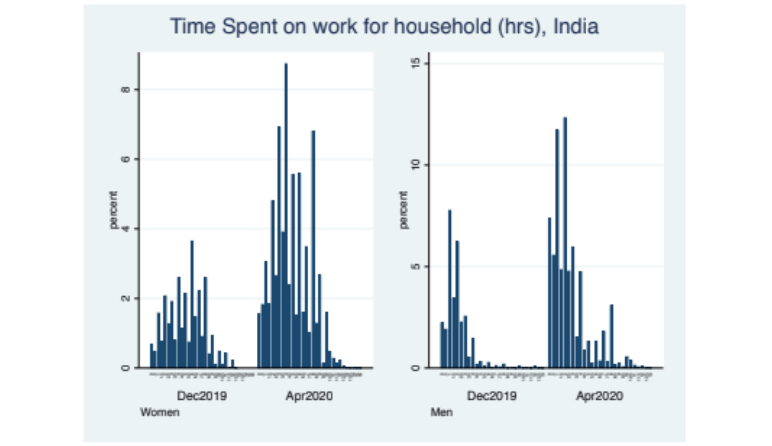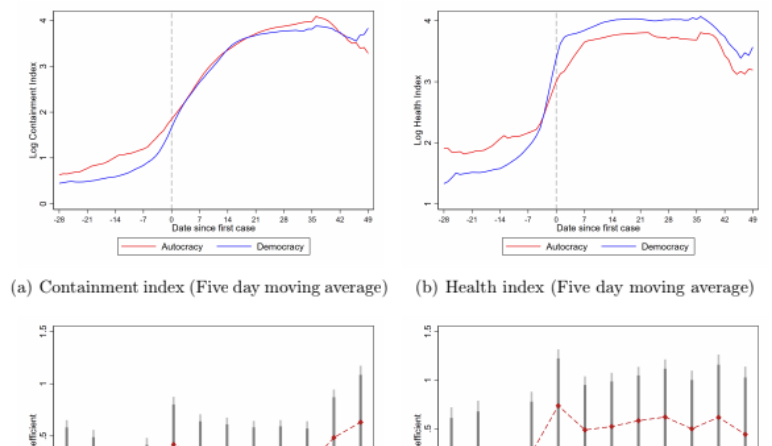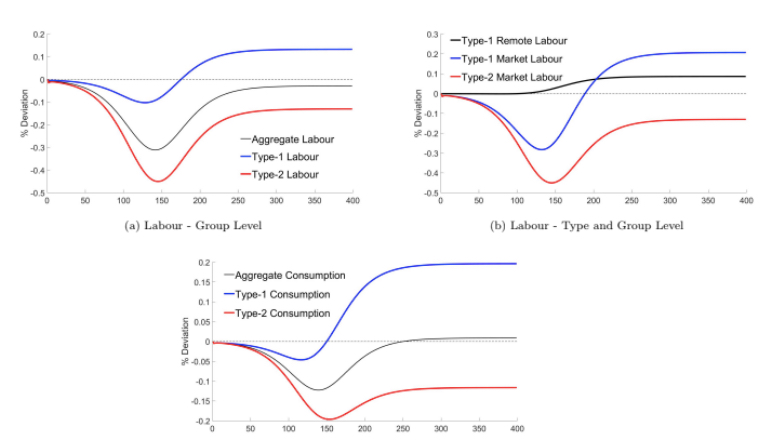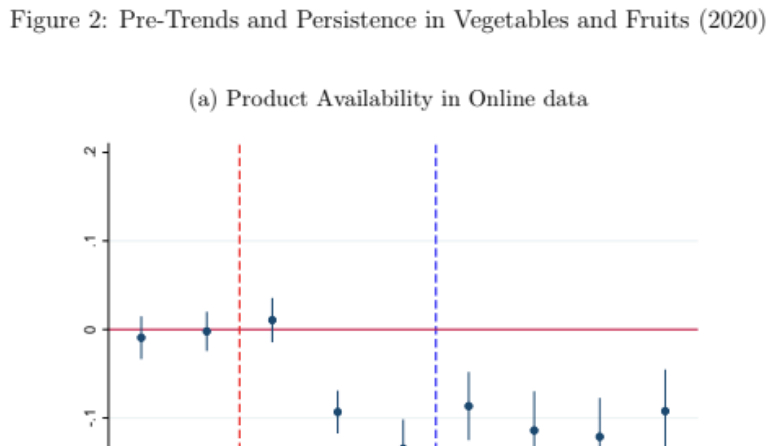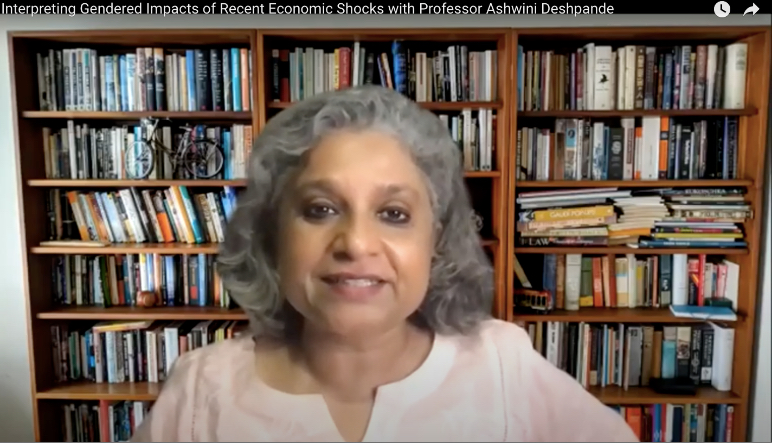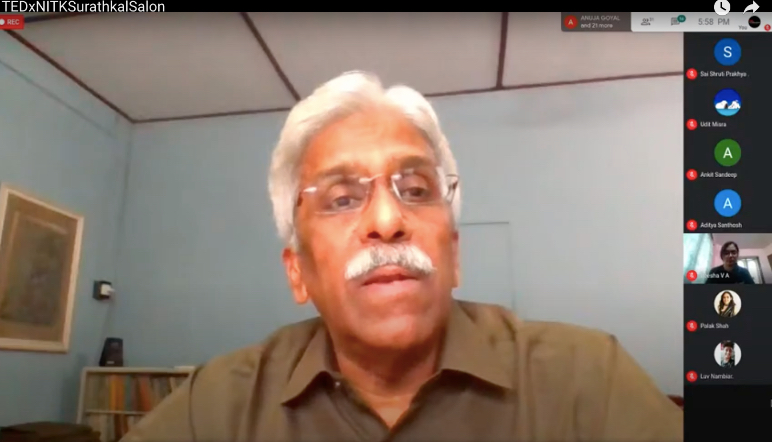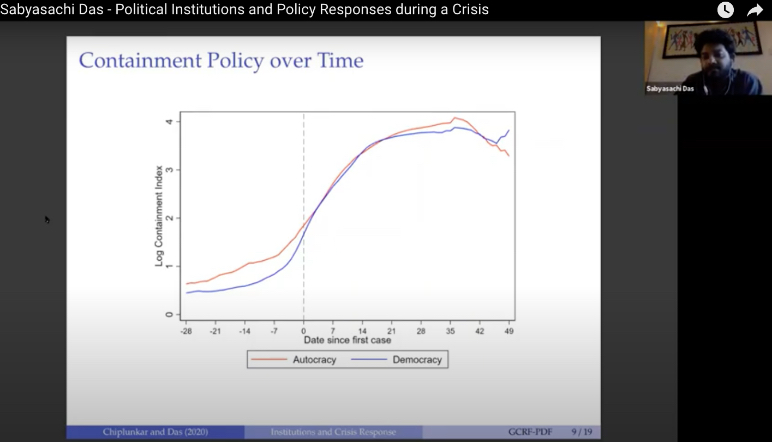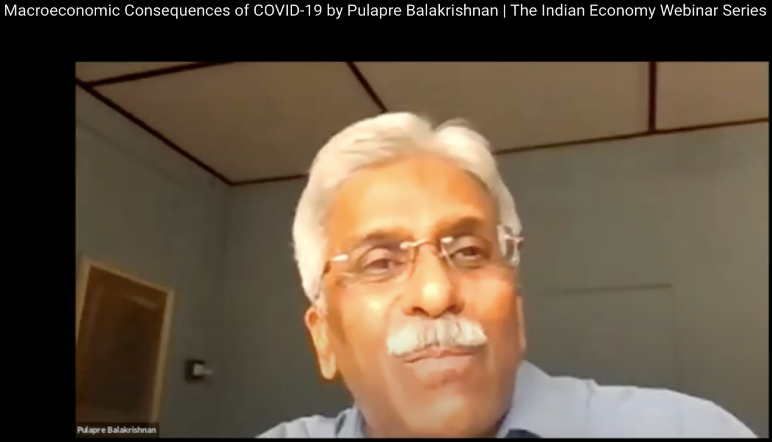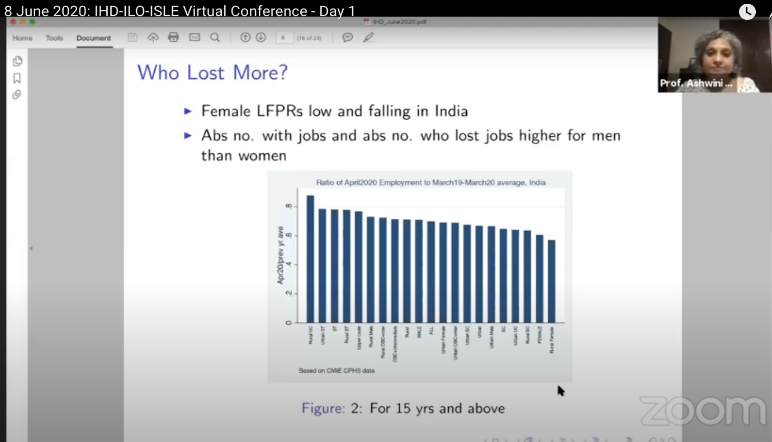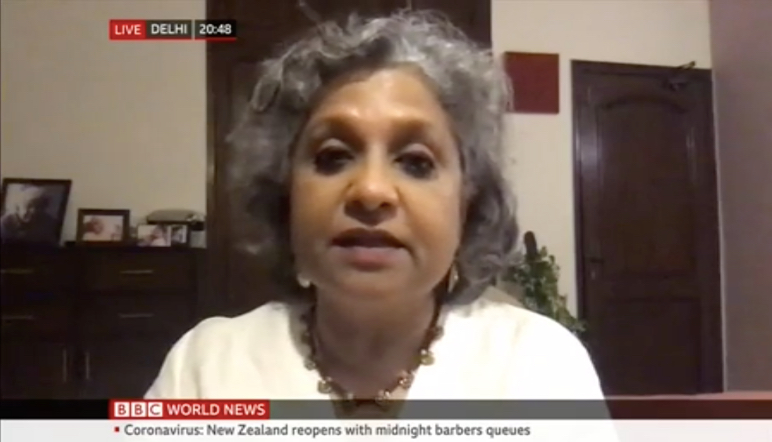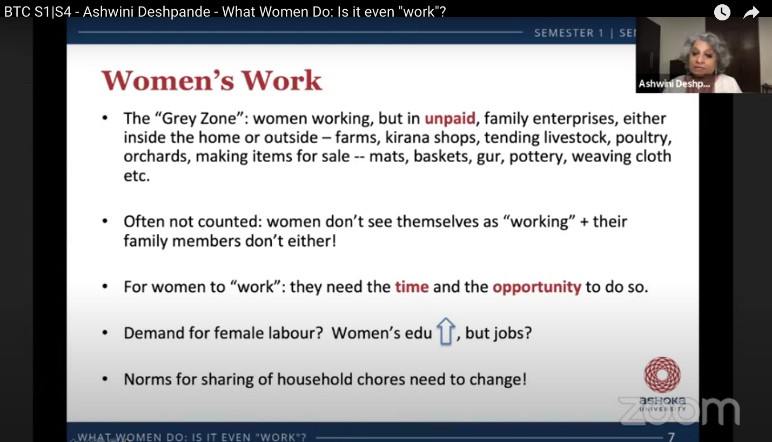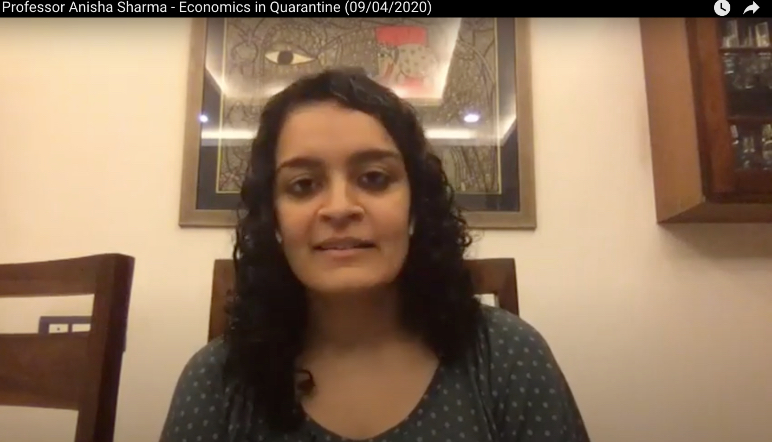Impact of the Lockdown on Incomes from Employment
By Aloke Kar & P C Mohanan | 4 February 2022 Keywords : Covid-19, Employment, Income, Lockdown, PLFSWhat was the impact of the lockdown on earnings from employment? A look at PLFS data.
Read moreASER 2021: The Pandemic Widens the Gap
By Ankur Bhardwaj | 20 December 2021 Keywords : ASER, Covid-19, Education, Schooling, SchoolsYes, the pandemic has affected school enrollment in rural India. Here is what ASER 2021 tells us
Read moreTrue Impact of Lockdown on Employment
By Aloke Kar & P C Mohanan | 9 November 2021 Keywords : Covid-19, Employment, Gender, Industry, Lockdown, PLFS, Unemployment, WagesHow did the Covid-19 lockdown affect employment? What does PLFS data indicate?
Read moreWill there be a third wave?
By Shahid Jameel | 15 July 2021Quartz India republishes the CEDA data narrative on the possibility of India facing a third wave of Covid-19.
Read morePicture This: Deaths of apathy
By Team CEDA | 15 July 2021 Keywords : Coronavirus, Covid Deaths, Covid Fatality, Covid-19, Healthcare, IndiaWhich Indian states had the highest Covid fatality rate and which had the highest caseload per lakh of population?
Read moreWill India face a third wave of Covid-19?
By Shahid Jameel | 12 July 2021 Keywords : Coronavirus, Covid-19, Healthcare, IndiaThree factors will determine the timing and magnitude of future waves of the coronavirus pandemic in India. What are those?
Read morePicture This: Air pollution affecting Covid fatality in India?
By Team CEDA | 9 July 2021 Keywords : Air Pollution, Coronavirus, Covid Fatality, Covid-19, Healthcare, IndiaDid cities with high levels of air pollution see higher Covid fatality rates? What does data tell us?
Read moreGold, real-estate or business: How do households intend to save?
By Ankur Bhardwaj & Ashwini Deshpande | 1 July 2021 Keywords : Business, Covid-19, Economy, Gold, Household Savings, Real Estate, SavingsWhere do households intend to invest their savings? Is gold more popular than real estate and business? Here is what data tells us
Read moreCEDA EcoMeter: Under Covid’s shadow, economy hits a snag
By Ankur Bhardwaj & Vibhav Khandelwal | 7 June 2021 Keywords : Consumer Sentiment, Coronavirus, Covid-19, Economic Activity, Economy, GDP, Google Mobility, GST, Manufacturing, PMI, Power Consumption, ServicesSecond wave of the Covid pandemic has put a stop to the slow gains in economic activity made between October 2020 and March 2021
Read moreEPFO: Data shows the Covid pandemic hurt younger workforce more
By Ankur Bhardwaj & Kanika Mahajan | 31 May 2021 Keywords : Coronavirus, Covid, Covid-19, Economy, Employment, EPFO, Formal Jobs, Informal Jobs, Jobs, Social SecurityThe biggest setback of the Covid pandemic was to first-time labor market entrants, shows EPFO payroll data.
Read moreCovid-19: How vulnerable are Indian states?
By Mihir Bhattacharya & Panchali Banerjee | 28 May 2021 Keywords : Coronavirus, Covid-19, Economy, Health, Healthcare, India, StatesHow vulnerable were Indian states on healthcare and economy before Covid pandemic struck and how vulnerable are they now?
Read moreHealthcare Expenditure: A Festering Wound Ignored
By Ankur Bhardwaj | 13 May 2021 Keywords : Budget, Coronavirus, Covid, Covid19, Healthcare, IndiaFailure to allocate more funds for healthcare even after identifying the need has made the coronavirus pandemic deadlier for India
Read morePicture This: India’s Covid vaccinations take a dive
By Team CEDA | 7 May 2021As more Indians became eligible to get a vaccine shot, India saw its daily vaccination count decline instead of going up
Read moreCovid Vaccination Program: Not a Rosy Picture
By Sonal Agarwal & Ankur Bhardwaj | 27 April 2021 Keywords : Coronavirus, Covaxin, Covid-19, Covishield, Healthcare, VaccinationsWhat are the challenges India’s Covid-19 vaccination program faces? Where did it go wrong? Read to find out
Read moreCEDA Coronavirus Policy Brief: Still As Relevant
By Team CEDA | 21 April 2021 Keywords : Cash Transfer, Children, Covid-19, Employment, Health, Income, Livelihood, Migration, Pandemic, PDS, Violence, VulnerableAs India battles an unforgiving second wave of the Covid-19 pandemic, this CEDA Policy Brief from April 2020 can still help policy makers tackle its effects on people’s lives and the economy
Read moreCEDA Coronavirus Policy Brief: Still As Relevant
By Team CEDA | 20 April 2021 Keywords : Cash Transfer, Children, Covid-19, Employment, Health, Income, Livelihood, Migration, Pandemic, PDS, Violence, Vulnerable, WomenAs India battles an unforgiving second wave of the Covid-19 pandemic, this CEDA Policy Brief from April 2020 can still help policy makers tackle its effects on people’s lives and the economy
Read moreCovid-19: Income Shocks and Female Employment
By Ishaan Bansal & Kanika Mahajan | 14 April 2021 Keywords : Covid-19, Economy, Employment, Gender, Labour Force Participation, WomenWere changes in female labour force participation after the pandemic homogeneous in nature?
Read moreCovid-19 setback: The strongest reversal in India’s battle against extreme poverty
By Ankur Bhardwaj | 5 April 2021 Keywords : China, Covid-19, Economy, GDP, India, Per Capita IncomeThis analysis by Pew Research Centre shows the damage done to the Indian economy and livelihoods by the Covid-19 pandemic in 2020. At the start of another fiscal year, India is seeing a sharp rise in Covid-19 infections which is being called the second wave. This analysis points to the dangers of the pandemic continuing to wreak havoc on the Indian economy for an extended period.
Read moreCovid-19 and lockdown: How household expenses bore the brunt
By Ankur Bhardwaj | 25 March 2021 Keywords : Covid-19, Economy, Employment, Expenditure, IncomeIn February, we looked at the monthly household income and individual wage income data from CMIE’s Consumer Pyramids Household Survey. The data we analyzed in the CEDA-CMIE Bulletin 2, revealed the extent of damage the Covid-19 pandemic and the nationwide lockdown did to both household and individual wage incomes between April and September, 2020. This followed the first CEDA-CMIE Bulletin in which we looked at the impact the pandemic had on employment in the year 2020. In this CEDA-CMIE Bulletin we take a look at the impact of the pandemic and lockdown on household expenses in rural and urban India in the same period.
Read moreCovid-19 and lockdown: Impact on household and individual wage income
By Ankur Bhardwaj | 24 February 2021 Keywords : CMIE, Covid-19, Economy, IncomeEarlier this month, CMIE released the monthly household income and individual wage income for the month of September 2020. India entered the first complete lockdown from March 25, 2020. As all economic activity came to a complete halt, the first half of FY2020-21 bore the brunt of the pandemic.
Read moreCovid-19: Is India reporting fewer cases because of lower testing?
By Ankur Bhardwaj & Vibhav Khandelwal | 9 February 2021 Keywords : Covid-19, Covid-19 Fatality, Covid-19 Testing, UrbanizationIndia entered a three-week lockdown to tackle the Covid-19 pandemic in the month of March 2020. The first lockdown was announced on 24 March and remained in effect from 25 March 2020 to 14 April 2020. Ever since, attempts have been made to try and understand how India has fared with the coronavirus pandemic and how the country of more than 1.3 billion people has handled it.
Read moreIndia’s youth are facing an unprecedented jobs crisis and data has been telling us for some time. Read more to find out ... Read more
Yes, the pandemic has affected school enrollment in rural India. Here is what ASER 2021 tells us... Read more
Rural India's safety net has helped in times of Covid-19 but it may still be falling way short... Read more
Three factors will determine the timing and magnitude of future waves of the coronavirus pandemic in India. What are those?... Read more
Second wave of the Covid pandemic has put a stop to the slow gains in economic activity made between October 2020 and March 2021... Read more
The biggest setback of the Covid pandemic was to first-time labor market entrants, shows EPFO payroll data.... Read more
How vulnerable were Indian states on healthcare and economy before Covid pandemic struck and how vulnerable are they now?... Read more
Failure to allocate more funds for healthcare even after identifying the need has made the coronavirus pandemic deadlier for India ... Read more
What are the challenges India’s Covid-19 vaccination program faces? Where did it go wrong? Read to find out... Read more
As India battles an unforgiving second wave of the Covid-19 pandemic, this CEDA Policy Brief from April 2020 can still help policy makers tackle its effects on people’s lives and the economy... Read more
Were changes in female labour force participation after the pandemic homogeneous in nature?... Read more
This analysis by Pew Research Centre shows the damage done to the Indian economy and livelihoods by the Covid-19 pandemic in 2020. At the start of another fiscal year, India is seeing a sharp rise in Covid-19 infections which is being called the second wave. This analysis points to the dangers of the pandemic continuing to wreak havoc on the Indian economy for an extended period.... Read more
India entered a three-week lockdown to tackle the Covid-19 pandemic in the month of March 2020. The first lockdown was announced on 24 March and remained in effect from 25 March 2020 to 14 April 2020. Ever since, attempts have been made to try and understand how India has fared with the coronavirus pandemic and how the country of more than 1.3 billion people has handled it.... Read more
The Covid-19 pandemic and gendered division of paid work, domestic chores and leisure.
By Ashwini Deshpande | 17 November 2021Ashwini Deshpande discusses the effects of the first wave of the Covid-19 pandemic on the gender gaps in paid and unpaid work.
MGNREGA: 100 days of work? Barely a quarter
By Surya Sarathi Ray | 15 September 2021The Financial Express quotes a CEDA data narrative on why MGNREGA might still be falling short.
Will there be a third wave?
By Shahid Jameel | 15 July 2021Quartz India republishes the CEDA data narrative on the possibility of India facing a third wave of Covid-19.
The Way Forward After the Second Wave | Ashoka University
By Ashwini Deshpande, Shahid Jameel, Mekhala Krishnamurthy, Gautam Menon & Amita Baviskar | 7 July 2021The panelists from Ashoka University cover many diverse issues facing the country and possible remedies as it goes forward after the Second Wave of COVID-19.
Covid India: Women in rural Bihar hesitant to take vaccines
By Chinki Sinha | 1 July 2021BBC News quotes a CEDA Picture This entry as it reports on the hesitancy of women to take vaccines in rural Bihar.
As India gets vaccinated, women are falling behind. We must mind this gap
By Ashwini Deshpande | 21 June 2021Ashwini Deshpande writes: Mass vaccination can succeed only when we take into account structural inequalities, recognise the specific challenges these impose, and find solutions to circumvent them.
COVID-19 impact: Indian households spent more on food, less on healthcare during first lockdown
By Anirudh Tagat | 8 April 2021Indian households reallocated their expenditures due to the impact of COVID-19, writes Firstpost as it quotes the CEDA-CMIE Bulletin.
Indian household incomes still haven’t recovered from the Covid-19 shock
By Manavi Kapur | 26 February 2021The Covid-19 pandemic and the lockdowns hurt already declining household and individual wage incomes, writes Quartz India as it quotes the CEDA-CMIE Bulletin.
True fiscal responsibility
By Pulapre Balakrishnan | 7 December 2020We see in it that gross fixed capital formation at constant prices actually increased in Quarter 2, indeed by a whopping 60 percent...Three other sources of expenditure exist, namely, exports, private final consumption expenditure and government final consumption expenditure. The first two show a substantial increase over their Quarter 1 levels but government final consumption expenditure actually declines by 25 percent over the same period. Could it be that the contraction in GDP would have been less but for this cut in government expenditure?
Some of the COVID-19 mortality was avoidable
By Pulapre Balakrishnan & Sreenath K Namboodhiry | 24 November 2020While there is a strong relationship between the death rate and public health expenditure, there is much less between the death rate and medical infrastructure in the public sector, be it hospitals or hospital beds per person. The clue to this most likely lies in the observation made by the well-known surgeon, Dr. Devi Prasad Shetty that: “it is doctors who treat patients, not hospital beds” (NDTV, October 2, 2020).
Pandemics and women’s labour market participation in India: A long view
By Ashwini Deshpande & Bishnupriya Gupta | 20 November 2020The experience of the pandemic teaches us that a normalisation of ‘working from home’ supposedly allows women to participate in paid work and simultaneously take care of domestic responsibilities. However, without changes that ensure more equality in domestic work as well as in paid work opportunities and more importantly changes in social norms about women’s work, we are unlikely to see a significant change in women’s participation in the labour force.
A normalisation of WFH is unlikely to raise women’s participation in the labour force
By Ashwini Deshpande | 6 November 2020The experience of the pandemic teaches us that a normalisation of WFH — without concomitant changes that reduce the burden of domestic chores and care work, and an increase in paid work opportunities — is unlikely to raise women’s participation in the labour force. As the pandemic forces our economy to hit the “reset” button, paying attention to job creation with a gender equity lens is essential for India to realise its tremendous gender dividend.
The RBI tunes in to the economy
By Pulapre Balakrishnan | 15 October 2020In the recent reconstitution of the Monetary Policy Committee, which conducts monetary policy in India, we can find a refreshing shift away from dogma. Not all its members may be macro-economists in the conventional sense but their work conveys that they will not be governed by rigid adherence to the model of inflation underlying RBI’s inflation targeting policy.
Reversing the economic reversal
By Pulapre Balakrishnan | 7 September 2020The lockdown was justified on the grounds that lives are more important than livelihoods. But, life having to be lived without a livelihood is not acceptable five months after the lockdown was first imposed.
Post-Lockdown, Marginalised Castes Suffered More Job Losses
By Ashwini Deshpande | 6 September 2020Since the upper castes have more access to education and thereby have more secure jobs, they are less vulnerable to economic shocks such as the one produced by the lockdown. Therefore, we see that pre-existing faultlines, structural inequalities based on caste identity, reveal themselves yet again in the immediate post-lockdown job losses.
What Would Make India’s Growth Sustainable?
By Bharat Ramaswami, Maitreesh Ghatak & Ashok Kotwal | 4 September 2020Rural-led growth relying on domestic demand is not likely to generate such high rates of growth. However, slower growth that directly benefits the bottom tier of population and generates its own momentum for a long enough time to transform the whole economy is preferable to a rapid burst that benefits only a few and exhausts itself in a short time.
Interpreting Gendered Impacts of Recent Economic Shocks
By Ashwini Deshpande | 22 August 2020Now that work from home has become normalised for everybody, hopefully, the stigma that was attached earlier to working from home, which was transferred to women workers, will be eliminated. If that was the reason for employers to either not hire women or to hire them in lower proportions, hopefully, that would change.
Fighting the coronavirus: How to get vaccines speedily to people who need them, once one has been found
By Bhaskar Dutta | 19 August 2020Nobel Laureate Joseph Stiglitz suggested a partial alternative to the patent system that would both incentivise research but avoid monopoly pricing. This involved a government creating a “Prize Fund”. The Fund would then award prizes to those companies that successfully develop preventions or treatments of diseases affecting large numbers of people.
How to pay for the stimulus
By Pulapre Balakrishnan | 6 August 2020The media has recently reported some economists responding to the suggestion of money financing with the Friedmanesque quip “there ain’t no free lunch”. But it may be mentioned that there is no free lunch in the case of debtfinancing either. Not only have the moneys to be repaid, they will have to be paid back in hard currency.
AtmaNirbhar Bharat
By Pulapre Balakrishnan | 1 August 2020I do not see the economic package unvelied by the PM contributing significantly even to a revival of the economy leave alone leading to self-reliance which is what ‘Atmanirbhar’ means.
Did Indian Men Do More Housework During Lockdown? It Depends
By Ashwini Deshpande | 29 July 2020It is also worth noting that the data confirms that, even with men helping out more around the house in April 2020, domestic chores are still overwhelmingly performed by women. In this sense, India is not an exception to the global pattern. It also remains to be seen if this trend persists after April 2020.
Adopting a public systems approach to COVID-19
By Pulapre Balakrishnan | 29 July 2020So, States of India harbouring greater wealth than most have registered a higher mortality rate from COVID-19 even as some with far less have succeeded in containing them…Clearly wealth is not always health; when an epidemic strikes public capital in the form of a strong health infrastructure is.
Political Institutions and Policy Responses during a Crisis
By Sabyasachi Das | 27 July 2020We find that autocracies are much more preemptive in their policy response. However, right after the first case is registered, democracies are very quick in ramping up their testing policy, contact-tracing policy and public campaigning. In fact, they surpass the autocracies.
Macroeconomic Consequeces of COVID-19
By Pulapre Balakrishnan | 11 July 2020The response of the Government of India to the likely COVID-induced recession is incommensurate. Assuming production is spread evenly across the year, the two month lockdown may be estimated to have wiped out the equivalent of a sixth of the GDP for 2019-20, which was Rs. 203,84,759 crores.
Gender Disparity in India’s Lockdown-Induced Job Losses
By Ashwini Deshpande | 24 June 2020On one hand, you see a dop in their [women's] employment. On the other hand, you see that when you think of a stigmatized job that dalits do or these very risky frontline health jobs, they seem to be exclusively reserved for women.
To revive the economy, Modi must turn to maximum government
By Pulapre Balakrishnan | 21 June 2020The economic package announced by the finance minister in mid-May was not a stimulus, as it does not inject demand into the economy. Greater public spending alone can do that at the present juncture. But, for some reason the government has shied away from undertaking it.
Is work from home feasible in the long run?
By Ashwini Deshpande & Ramkumar Ramamoorthy | 12 June 2020I do hope that increased possibilities of employment for women will go hand in hand with changes in the gender workload sharing norms inside the house. Which can happen by the way, because with the World Wars, there is evidence in Europe that gender norms for sharing work in a house did change.
Implications of the Covid-19 Crisis for Labour and Employment in India: Impact, Strategies and Perspectives
By Ashwini Deshpande | 8 June 2020On average, in India, employment in April 2020 was about 67% of employment in the previous year...Women relative to their employment level pre-lockdown lost more jobs relative to men and within women it was driven by rural women.
Provide Equity, Not Debt
By Anisha Sharma & Marti G Subrahmanyam | 31 May 2020The government should offer to make direct investments in businesses by taking a 'minority stake', which will be recovered through higher taxes on profits over a number of years. By making payments conditional on profitability, rather than saddling firms with repayable debt, equity finance will be more sustainable in the long term.
To Rebuild the Economy, India Needs to Be Atmanirbhar in Ideas
By Pulapre Balakrishnan | 30 May 2020In a striking demonstration of what can go wrong if we do not keep our own counsel, today India finds herself saddled with an economic model of unbounded growth that destroys natural capital and a political model based on the vision of a majoritarian nation-state that promises endless social turmoil. It is not clear that a course correction will emerge from India’s political parties competing for power. Only a collective effort can achieve it.
Gender Matters: COVID-19 and the labour market in the Global South
By Ashwini Deshpande | 28 May 2020When women have less decision-making power than men, either in households or government, their needs are less likely to be met. The shadow pandemic is as real in India as anywhere else...Being gender-blind doesn't mean that the policy is gender-neutral.
What Does Work-From-Home Mean for Women?
By Ashwini Deshpande | 23 May 2020It has been estimated that in 2019, the imputed value of this unpaid reproductive work by women was equivalent of $10.9 trillion, which is more than the earnings of the top 50 firms in the world in 2018 (Wezerek and Ghodsee 2020). The monetary imputation is useful to understand the sheer magnitude of unpaid work.
Lessons from online retail data on our food supply chains
By Kanika Mahajan & Shekhar Tomar | 21 May 2020Overall, we have found that supply chains in India disrupted in the aftermath of the first lockdown have since recovered somewhat. However, they continue to be disrupted in the case of perishables.
The economic package unpacked
By Pulapre Balakrishnan | 18 May 2020The conclusion is that the government is keen on signalling fiscal prudence by sticking as far as possible to the deficit in the budget announced. We can now see that behind the finance ministry’s announcement last week that it is raising the public borrowing limit for the financial year is the reality that the government’s revenues are set to fall behind its expenditure, and not any preparation for the stimulus to come.
Monitoring Economic activity in Real time: Interview with Professor Bhagwan Chowdhry
By Kanika Mahajan & Shekhar Tomar | 17 May 2020I see a huge scope for this data and we need to find out ways to be able to make use of it for making intelligent policy decisions and see where the economy is going. Because that data is available to us everyday, be it data from job portal, banking or retail.
Life after Lockdown: Gender equality
By Ashwini Deshpande | 14 May 2020Overall, the representation of women in decision-making bodies is not that high at all...What that does is that it makes the gendered impacts invisible. To maintain or improve gender equality, policies will have to be gender-targeted in terms of their impacts.
Living with lockdowns: Early lessons from India’s COVID-19 response
By Ashwini Deshpande | 14 May 2020Women do between six to nine times more hours of domestic work than men...Ignoring gender will slow down the fight against COVID-19. Flattening the pandemic curve should not be at the expense of shadow pandemic curve rising exponentially.
League of nations: guessing our way out of lockdown
By Ashwini Deshpande | 14 May 2020In the fight against COVID-19, many other essential diseases and outbreaks are getting ignored. Now we're getting reports about Dengue, Malaria and Chikungunyaa, which are also killer diseases...There's a whole range of public health emergencies even if you didn't count the economic costs of the lockdown.
Financing the Covid-19 economic package
By Pulapre Balakrishnan | 14 May 2020For the moment, the government should seriously consider the money financing route as funding the deficit will raise interest rates. An objection encountered is that the former is inevitably inflationary. Actually, it is not more so than monetary easing implemented by the central bank.
France Eases Lockdown
By Ashwini Deshpande | 11 May 2020What the pandemic is revealing is just how important migrants are to production and service provision in the Indian economy. I don't think the magnitude of the migrant's contribution to the economy was ever as clear as it is now. It's really a very big segment of the workforce, on the backs of which industries and services run in this country.
INDIA: Surmounting the economic challenges of COVID-19
By Aparajita Dasgupta, Ashwini Deshpande & Anisha Sharma | 1 May 2020The recovery programme proposed has two components – to provide a comprehensive safety net for vulnerable sections and to jumpstart the economy. This is ambitious and requires a sizeable outlay, notably 10% of GDP as proposed in the report. But, in view of the magnitude of the crisis, we agree that the cost is worth it and fiscal sustainability should not be a concern right now.
After Covid-19: Potential Challenges for Kerala’s Economy
By Pulapre Balakrishnan | 30 April 2020While Kerala’s human development achievements are indeed noteworthy and could serve as a model of sorts for much of the rest of the country, the heavy shortfall in its production of the items of everyday consumption takes away from its overall economic performance.
Amend the FRBM Act, and spend more now
By Pulapre Balakrishnan | 29 April 2020Not amending the Act is one of the sources of the paralysis in economic policy today. It ensures that the government cannot expand its spending to battle the consequences of the spread of the coronavirus. Greater expenditure is required in four buckets, first for relief, next for the medical response, then for an aggregate demand stimulus and, finally, for ramping up the public health infrastructure.
Rejuvenating MSME sector in the corona crisis: Firms are better supported through “pseudo-equity” than debt finance
By Anisha Sharma & Marti G Subrahmanyam | 28 April 2020Many MSMEs were struggling even before the pandemic reached India. GDP growth is the lowest in a decade, and MSMEs carry debt of Rs 69 lakh crore, 84% of which is self-financed or raised from expensive informal sources. Adding to this debt during a crisis would prove burdensome.
Developing Nations and COVID 19
By Ashwini Deshpande | 23 April 2020Looking at the pandemic and its responses through the gender lens is needed, if not for anything else then just to contain the pandemic...If we want to understand the gendered nature of the COVID and the pandemic, we need to collect gender disaggregated data.
It is our constitutional duty to ensure a safety net for the economically weaker sections of society
By Abhinash Borah & A K Patnaik | 19 April 2020Restrictions that are being imposed by the State, even if they are presumed to be necessary in the present circumstances, have deprived the right of people to their livelihoods, and therefore their Right to Life. Such restrictions would become unreasonable, arbitrary and unconscionable, if immediate steps are not taken to compensate the people worst affected by these restrictions so as to enable them to afford the basic necessities of life.
As India battles a grave health and economic crisis, it must put humanity centrestage
By Abhinash Borah, Sabyasachi Das, Aparajita Dasgupta, Ashwini Deshpande, Kanika Mahajan, Bharat Ramaswami, Anuradha Saha & Anisha Sharma | 18 April 2020Then pandemic will abate one day, but if it leaves behind a large population that is unhealthy because of being deprived of minimum subsistence, it will adversely impact India’s growth potential for several years to come.
In locked down India, women fight coronavirus and domestic violence
By Ashwini Deshpande | 16 April 2020The chart shows that there is already a sharp jump in complaints related to domestic violence and the “right to live with dignity”, and a smaller increase in rape/attempt to rape and sexual assault. The last two charges are telling, as this number covers two weeks of complete lockdown (therefore no movement outside the home), and reduced mobility in March due to fear of infection. Thus, these rapes and assaults include those perpetrated by family members.
What Women Do: Is it even “work” ?
By Ashwini Deshpande | 15 April 2020Women who are working, for them it's not just about doing well at their jobs. But it's about doing well at the jobs, crossing the hurdle race which involves cooking, cleaning, ironing and washing clothes repeatedly.
India needs a strong fiscal stimulus
By Pulapre Balakrishnan | 15 April 2020Though Prime Minister Narendra Modi has stated “Jaan bhi aur jahan bhi”, implying that the economy cannot be ignored even as we are engaged in saving lives, the government is yet to announce a stimulus beyond a meagre relief package of Rs 1.7 lakh crore.
Economics in Quarantine
By Anisha Sharma | 9 April 2020Given the lockdown, what is not negotiable is extensive and generous government spending to compensate for the known costs of the lockdown at the individual and the household level...As long as you're able to afford making those kinds of social transfers, you can go ahead and decide that this is the lockdown that you need to institute.
Nirmala Sitharaman Should Remember That a Stimulus Delayed Is a Quick Recovery Denied
By Pulapre Balakrishnan | 9 April 2020While relief is of the essence in the short term, the far greater task is that of a reconstruction that must follow. Reconstruction would entail both energising an economy that would have slowed during the lockdown, but also building one that would contain the goods needed to make life in India more secure in the future.
Impact of Covid-19 on the World Economy
By Biswajit Banerjee | 1 April 2020The latest projections of GDP growth for the Indian economy in FY21 range from –0.5 per cent (Nomura) to 2.5 per cent (Moody’s). The Economic Intelligence Unit projects a quarter-on quarter growth of –9.3 per cent in Q2, 2020. If the social distancing measures remain in place for a relatively extended period and it takes time for business and consumer confidence to return and normal business operations to resume, then GDP growth in FY21 might well be toward the lower end of the range.
Protecting women is missing from pandemic management measures in India
By Ashwini Deshpande | 28 March 2020The most horrific and obvious impact of the lockdown imposed to flatten the curve has been a rise in domestic and intimate partner violence (IPV) as has been noted for the US, the UK, and China, among other countries. A rise in domestic violence (DV) literally increases the risk to women’s lives: as one curve gets flattened, the other one slopes upwards, perhaps not exponentially, but sharply, nevertheless.
Teaching in the Time of Isolation
By Ashwini Deshpande | 24 March 2020But in this virtual non-existent classroom, there was nobody but me. And I was talking to my inanimate, unresponsive, expressionless iPad. I went through the lecture, occasionally repeating, occasionally pausing and completely clueless about whether I had managed to make a connection.
What data has been telling us: The job crisis is real
By Ankur Bhardwaj | 31 January 2022 Keywords : Bihar, CEDA-CMIE, CMIE, Covid-19, Demonetisation, Demonetization, Economy, Employment, EPFO, Jobs, Lockdowns, Manufacturing, Note Ban, Railways, RRB-NTPC, Unemployment, Uttar Pradesh, Youth UnemploymentIndia’s youth are facing an unprecedented jobs crisis and data has been telling us for some time. Read more to find out
Read moreCEDA-CMIE: India’s shrinking female workforce
By Ankur Bhardwaj | 14 January 2022 Keywords : CEDA-CMIE, CMIE, Covid-19, Economy, Employment, Female Employment, Female Labour, Gender, Jobs, Labour, Male Employment, States, UEWL, UnemployedNot only are fewer women employed in India in 2021, even fewer are now actively looking for jobs, shows CMIE data
Read moreTrue Impact of Lockdown on Employment
By Aloke Kar & P C Mohanan | 9 November 2021 Keywords : Covid-19, Employment, Gender, Industry, Lockdown, PLFS, Unemployment, WagesHow did the Covid-19 lockdown affect employment? What does PLFS data indicate?
Read moreCovid and jobs: The salaried, younger workers, and women suffered more
By Ankur Bhardwaj | 24 September 2021 Keywords : Agriculture, CEDA-CMIE, CMIE, Economy, Employment, Farming, Gender, Jobs, LabourYoung people, women, salaried employees, small traders and wage laborers have suffered more job losses with farming being the only fallback option
Read moreMGNREGA: The Rescue Act in Need of Assistance
By Ankur Bhardwaj & Ashwini Deshpande | 10 September 2021 Keywords : Coronavirus, Covid-19, Economy, Employment, Employment Guarantee, Labor, Labour, MGNREGA, NREGA, Rural IndiaRural India's safety net has helped in times of Covid-19 but it may still be falling way short
Read morePeriodic Labour Force Survey 2019-20: What does it tell us?
By P C Mohanan | 12 August 2021 Keywords : Economy, Employment, Gender, Labour, Labour Force, PLFS, Unemployment, WorkforcePeriodic labour Force Survey 2019-20: what does it tell us?
Read moreEPFO: Data shows the Covid pandemic hurt younger workforce more
By Ankur Bhardwaj & Kanika Mahajan | 31 May 2021 Keywords : Coronavirus, Covid, Covid-19, Economy, Employment, EPFO, Formal Jobs, Informal Jobs, Jobs, Social SecurityThe biggest setback of the Covid pandemic was to first-time labor market entrants, shows EPFO payroll data.
Read moreCEDA Coronavirus Policy Brief: Still As Relevant
By Team CEDA | 21 April 2021 Keywords : Cash Transfer, Children, Covid-19, Employment, Health, Income, Livelihood, Migration, Pandemic, PDS, Violence, VulnerableAs India battles an unforgiving second wave of the Covid-19 pandemic, this CEDA Policy Brief from April 2020 can still help policy makers tackle its effects on people’s lives and the economy
Read moreCovid-19: Income Shocks and Female Employment
By Ishaan Bansal & Kanika Mahajan | 14 April 2021 Keywords : Covid-19, Economy, Employment, Gender, Labour Force Participation, WomenWere changes in female labour force participation after the pandemic homogeneous in nature?
Read moreCovid-19 and lockdown: How household expenses bore the brunt
By Ankur Bhardwaj | 25 March 2021 Keywords : Covid-19, Economy, Employment, Expenditure, IncomeIn February, we looked at the monthly household income and individual wage income data from CMIE’s Consumer Pyramids Household Survey. The data we analyzed in the CEDA-CMIE Bulletin 2, revealed the extent of damage the Covid-19 pandemic and the nationwide lockdown did to both household and individual wage incomes between April and September, 2020. This followed the first CEDA-CMIE Bulletin in which we looked at the impact the pandemic had on employment in the year 2020. In this CEDA-CMIE Bulletin we take a look at the impact of the pandemic and lockdown on household expenses in rural and urban India in the same period.
Read moreASER 2021: The Pandemic Widens the Gap
By Ankur Bhardwaj | 20 December 2021 Keywords : ASER, Covid-19, Education, Schooling, SchoolsYes, the pandemic has affected school enrollment in rural India. Here is what ASER 2021 tells us
Read morePicture This: How bad is India’s digital divide?
By Team CEDA | 11 June 2021 Keywords : Covid, Digital Divide, Economy, Human Development, NFHS, NFHS 5Across 22 states and UTs, just over 6 out of 10 men had ever used the internet while the number was just over 4 out of 10 for women.
Read moreCovid-19 setback: The strongest reversal in India’s battle against extreme poverty
By Ankur Bhardwaj | 5 April 2021 Keywords : China, Covid-19, Economy, GDP, India, Per Capita IncomeThis analysis by Pew Research Centre shows the damage done to the Indian economy and livelihoods by the Covid-19 pandemic in 2020. At the start of another fiscal year, India is seeing a sharp rise in Covid-19 infections which is being called the second wave. This analysis points to the dangers of the pandemic continuing to wreak havoc on the Indian economy for an extended period.
Read moreCEDA-CMIE: India’s shrinking female workforce
By Ankur Bhardwaj | 14 January 2022 Keywords : CEDA-CMIE, CMIE, Covid-19, Economy, Employment, Female Employment, Female Labour, Gender, Jobs, Labour, Male Employment, States, UEWL, UnemployedNot only are fewer women employed in India in 2021, even fewer are now actively looking for jobs, shows CMIE data
Read morePicture This: Covid vaccination leaving women behind
By Team CEDA | 5 June 2021 Keywords : Coronavirus, Covid, Covid19, Gender, Health, Healthcare, VaccinationOnly 90 women are getting vaccinated against Covid in India for every 100 men vaccinated.
Read morePicture This: Deaths of apathy
By Team CEDA | 15 July 2021 Keywords : Coronavirus, Covid Deaths, Covid Fatality, Covid-19, Healthcare, IndiaWhich Indian states had the highest Covid fatality rate and which had the highest caseload per lakh of population?
Read moreWill India face a third wave of Covid-19?
By Shahid Jameel | 12 July 2021 Keywords : Coronavirus, Covid-19, Healthcare, IndiaThree factors will determine the timing and magnitude of future waves of the coronavirus pandemic in India. What are those?
Read morePicture This: Air pollution affecting Covid fatality in India?
By Team CEDA | 9 July 2021 Keywords : Air Pollution, Coronavirus, Covid Fatality, Covid-19, Healthcare, IndiaDid cities with high levels of air pollution see higher Covid fatality rates? What does data tell us?
Read morePicture This: Covid vaccination leaving women behind
By Team CEDA | 5 June 2021 Keywords : Coronavirus, Covid, Covid19, Gender, Health, Healthcare, VaccinationOnly 90 women are getting vaccinated against Covid in India for every 100 men vaccinated.
Read moreHealthcare Expenditure: A Festering Wound Ignored
By Ankur Bhardwaj | 13 May 2021 Keywords : Budget, Coronavirus, Covid, Covid19, Healthcare, IndiaFailure to allocate more funds for healthcare even after identifying the need has made the coronavirus pandemic deadlier for India
Read morePicture This: India’s Covid vaccinations take a dive
By Team CEDA | 7 May 2021As more Indians became eligible to get a vaccine shot, India saw its daily vaccination count decline instead of going up
Read morePicture This: Covid vaccine allocation is a picture of inconsistency
By Sonal Agarwal & Ankur Bhardwaj | 28 April 2021India’s Covid vaccination program hasn’t taken off. How have Covid vaccines been allocated to states? Is there a pattern?
Read moreCovid Vaccination Program: Not a Rosy Picture
By Sonal Agarwal & Ankur Bhardwaj | 27 April 2021 Keywords : Coronavirus, Covaxin, Covid-19, Covishield, Healthcare, VaccinationsWhat are the challenges India’s Covid-19 vaccination program faces? Where did it go wrong? Read to find out
Read moreCEDA Coronavirus Policy Brief: Still As Relevant
By Team CEDA | 21 April 2021 Keywords : Cash Transfer, Children, Covid-19, Employment, Health, Income, Livelihood, Migration, Pandemic, PDS, Violence, VulnerableAs India battles an unforgiving second wave of the Covid-19 pandemic, this CEDA Policy Brief from April 2020 can still help policy makers tackle its effects on people’s lives and the economy
Read moreCovid-19: Is India reporting fewer cases because of lower testing?
By Ankur Bhardwaj & Vibhav Khandelwal | 9 February 2021 Keywords : Covid-19, Covid-19 Fatality, Covid-19 Testing, UrbanizationIndia entered a three-week lockdown to tackle the Covid-19 pandemic in the month of March 2020. The first lockdown was announced on 24 March and remained in effect from 25 March 2020 to 14 April 2020. Ever since, attempts have been made to try and understand how India has fared with the coronavirus pandemic and how the country of more than 1.3 billion people has handled it.
Read moreThe Interstate Variation in Mortality from COVID-19 in India
By Pulapre Balakrishnan & Sreenath K Namboodhiry | 7 February 2021 Topics : Covid-19, Health, Public PolicyWhile the response to COVID-19 by the Government of India has been more or less uniform across the country, in that a lockdown was imposed throughout, the death rate has varied across the states. This suggests that region-specific factors are likely to be relevant to the determination of this rate. A significant aspect of this study is the use of three different measures of the death rate in the empirical exercise.
Read moreThe COVID-19 Pandemic and Gendered Division of Paid and Unpaid Work: Evidence from India
By Ashwini Deshpande | 1 October 2020 Topics : Covid-19, Employment, Gender, Incomes, India, Lockdown, Time UseExamining high frequency national-level panel data from Centre for Monitoring Indian Economy (CMIE) on paid work (employment), unpaid work (time spent on domestic work) and incomes, this paper examines the effects of the Covid-19 pandemic on the gender gaps in paid and unpaid work through the lockdown and recovery phases. The first month of the national lockdown, April 2020, saw a large contraction in employment for both men and women, where more men lost jobs in absolute terms. Employment has recovered by August 2020 for men. However, for women, the likelihood of being employed is 9.5 percentage points lower than that for men, compared to the pre-pandemic period. Men spent more time on housework in April 2020, but by August the average male hours had declined, though not to the pre-pandemic levels. Time spent with friends fell sharply for both men and women in April, to recover in August, but not to the pre-pandemic levels. The paper also examines available income data to find the sharpest contraction of incomes in the rural sector for both men and women.
Read moreIs COVID-19 “The Great Leveler”? The Critical Role of Social Identity in Lockdown- induced Job Losses
By Ashwini Deshpande & Rajesh Ramachandran | 1 July 2020 Topics : Caste, Covid-19, Employment, India, LockdownUsing nationally representative panel data for 21,799 individuals between May 2018 and April 2020, this paper investigates whether the Covid-19 pandemic was indeed a “Great Leveler” in the sense that it imposed similar and equivalent labour market shocks on different caste groups. We find that while all caste groups lost jobs in the first month of the lockdown, the job losses for lowest-ranked caste are greater by factor of three. The data shows that the disproportionate effects stems from lower levels of human capital and over-representation in vulnerable jobs for the lowest ranked caste groups in the country.
Read moreThe Covid-19 Pandemic and Lockdown: First Effects on Gender Gaps in Employment and Domestic Work in India
By Ashwini Deshpande | 17 June 2020 Topics : Caste, Covid-19, Employment, Gender, India, LockdownBased on national-level panel data from Centre for Monitoring Indian Economy (CMIE)’s Consumer Pyramids Household Survey (CPHS) database, this paper investigates the first effects of Covid-19 induced lockdown on employment and hours spent on household work. Identifying roughly over 40,000 individuals surveyed in April 2020 (i.e. during the strict nationwide lockdown) and examining their employment status over the last year, the paper finds that overall employment dropped sharply post-lockdown, with no change in the pre-pandemic time periods. This drop in employment was not gender neutral. Given the large pre-existing gender gaps in employment, in absolute terms, more men lost employment than women. However, conditional on being employed pre-lockdown, women were roughly 20 percentage points less likely to be employed than men who were employed pre lockdown. India has amongst the most unequal gender division of household work globally. Comparing hours spent on domestic work pre- and post-lockdown, we find that for men, hours spent on domestic work increased during lockdown. The gender gap in average hours spent on domestic work hours decreased in the first month of the lockdown, and most states showed a decline in the gender gap due to a shift in the male distribution of hours. The male distribution continues to be right-skewed, but the proportions of men doing between 0.5 to 4 hours of housework per day increased post-lockdown.
Read morePolitical Institutions and Policy Responses During a Crisis
By Sabyasachi Das & Gaurav Chiplunkar | 17 June 2020 Topics : Autocracy, Covid-19, Democracy, Electoral SystemsDo countries with differing political institutions respond differently to a national crisis? The coronavirus pandemic, where almost all countries were hit by the same crisis in a short span of time, provides a rare opportunity to answer this question. For a sample of 125 countries, we use high frequency data on two measures of policy response- (i) containment policies, relating to closure of public spaces and restrictions on movement of people, and (ii) health policies, relating to public information campaigns, testing and contact tracing, to examine their policy response to the crisis. We show that: first, non-democracies have more stringent containment and health policies prior to their first COVID-19 case. However, after registering their first case, democracies either close this gap (in containment policies), or surpass non-democracies (in health policies) within a week. Second, policy responses do not differ by governance systems (presidential or parliamentary) in democracies. However, elected leaders who performed better in the last election or face their next election farther in the future are more aggressive in their policy response. Third, democracies with greater media freedom respond more slowly in containment policies, but are more aggressive in health policies. Lastly, more conducive political norms (such as trust in the elected government) systematically predict a more ag- gressive response in both containment and health policies. Our analysis therefore suggests that political institutions and the incentives of the political leaders embedded therein, significantly shape the policy response of governments to a national crisis.
Read moreEpidemics: A Tale of Two Workers
By Rahul Nath | 1 June 2020 Topics : Covid-19, Epidemics, Heterogeneous Agents, Lockdown, Macroeconomic Labour, New Keynesian DSGEThis paper shows that the labour market opportunities available to an agent has a significant bearing on how that agent experiences the outbreak of an epidemic. I consider two types of labour (i) market labour that can only produce output in close physical proximity, and (ii) remote labour that can produce output at a distance. This paper develops a Two Agent New Keynesian model extended to include an epidemic bloc and dual feedback between economic decisions and the evolution of the epidemic. I show that an agent restricted to only supply market labour experiences higher death rates vis-`a-vis their share of the population, and suffers larger declines in labour and consumption over the course of the epidemic. Post-epidemic, these agents are significantly worse off than their counterparts who have the opportunity to work from home and hence a more unequal society emerges. I then show that simple containment policies, while leading to larger losses in economic prosperity as measured by output loss, can significantly reduce death rates across the population, bring the death rates of the two groups closer together, and reduce the inequality that emerges post epidemic.
Read moreHere Today, Gone Tomorrow: COVID-19 and Supply Chain Disruption
By Kanika Mahajan & Shekhar Tomar | 11 May 2020 Topics : Covid-19, Food, Online Data, Prices, Supply Chain DisruptionsThis paper looks at the disruption in food supply chains due to COVID-19 induced economic shutdown in India. We use a novel dataset from one of the largest online grocery retailers to look at the impact on product stock-outs and prices. We find that product availability falls by 10 percent for vegetables, fruits, and edible oils, while there is a minimal impact on their prices. On the farm-gate side, it is matched by a 20 percent fall in quantity arrivals of vegetables and fruits. We then show that supply chain disruption is the main driver behind this fall. We compute the distance to production zones from our retail centers and find that the fall in product availability and quantity arrivals is larger for items that are cultivated or manufactured farther from the retail centers. Our results show that long-distance food supply chains have been hit the hardest during the current pandemic with welfare consequences for urban consumers and farmers.
Read moreCEDA Coronavirus Policy Brief: Still As Relevant
By Team CEDA | 21 April 2021 Topics : Covid-19, Employment, Health, Income, Livelihood, MigrationAs India battles an unforgiving second wave of the Covid-19 pandemic, this CEDA Policy Brief from April 2020 can still help policy makers tackle its effects on people’s lives and the economy
Read moreThe Coronavirus Pandemic: Are we ready for the long haul?
By Abhinash Borah, Anisha Sharma, Anuradha Saha, Aparajita Dasgupta, Ashwini Deshpande, Bharat Ramaswami, Kanika Mahajan & Sabyasachi Das | 1 April 2020 Topics : Covid-19, Employment, Health, Income, Livelihood, MigrationWith nationwide lockdown and high unpredictability during COVID-19, this policy brief recommends a forward-looking relief package. The authors suggest disbursement of both cash and in-kind transfers to all households holding a ration card while strengthening the PDS system and supply chain simultaneously. In the second part of the brief, the authors recommend targeted policy measures for the few salient population groups. Special attention is drawn to some of the pressing issues, such as malnutrition amongst children, increased fertility rates, domestic and intimate partner violence, needs of temporary/seasonal migrant workers amongst other most vulnerable population groups.
Read more












